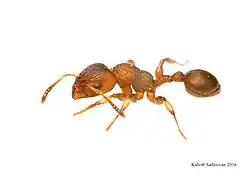Dilobocondyla bangalorica
| Dilobocondyla bangalorica | |
|---|---|

| |
| Scientific classification | |
| Kingdom: | Animalia |
| Phylum: | Arthropoda |
| Class: | Insecta |
| Order: | Hymenoptera |
| Family: | Formicidae |
| Subfamily: | Myrmicinae |
| Genus: | Dilobocondyla |
| Species: | D. bangalorica
|
| Binomial name | |
| Dilobocondyla bangalorica Varghese, 2006[1]
| |
Dilobocondyla bangalorica is a species of ant in the subfamily Myrmicinae.[2][3][4] It is endemic to India.[3][4] This arboreal ant nests in dead wood and crevices in tree barks.[1] The species name is after the type locality, Bangalore, where the ant was discovered in 2006.[1]
Ecology
The ants build their nest in the frangipani plant species Plumeria alba and Plumeria rubra. While they live in colonies like other ants, they forage individually on tree trunks.[1]
Description
Workers measure 3.4–4.1 mm (0.13–0.16 in) in total length. The species differs from other known species in the smaller size of worker and queen ants, the sculpted thorax and pedicel, colouration, six well defined mandibular teeth, and the lesser number of rugosities between the frontal carinae. The spines on the head and thorax are blunt, thus differentiating this species from others.[1]
References
- ^ a b c d e Verghese, Thresiamma (2006). "A new species of the ant genus Dilobocondyla (Hymenoptera: Formicidae) from India, with notes on nesting behaviour" (PDF). Oriental Insects. 40: 23–32. doi:10.1080/00305316.2006.10417454. S2CID 73664638.
- ^ "Dilobocondyla bangalorica Varghese, 2006". Catalogue of Life. Species 2000: Leiden, the Netherlands. Retrieved 18 July 2025.
- ^ a b "Species: Dilobocondyla bangalorica Varghese, 2006". AntWeb v8.114. California Academy of Science. 2025. Retrieved 18 July 2025.
- ^ a b Bharti, Himender; Guénard, Benoit; Bharti, Meenakshi; Economo, Evan P. (2016). "An updated checklist of the ants of India with their specific distributions in Indian states (Hymenoptera, Formicidae)". ZooKeys. 551: 1–83. doi:10.3897/zookeys.551.6767. PMC 4741291.